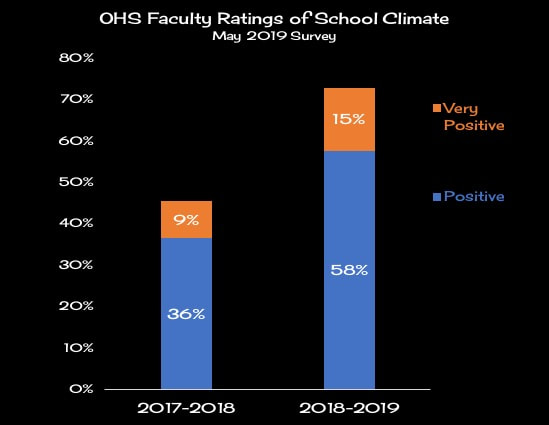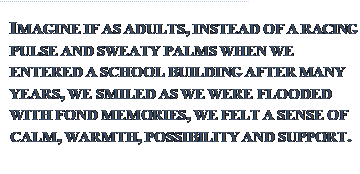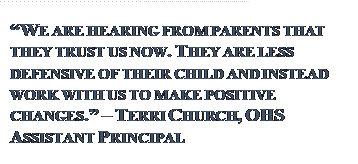By Carla White
“Thank you for not giving up on us.”
Those eight simple words from an Oceanside High School student to the Assistant Principal upon graduation sum up the positive impact that can result when a school embraces the massive, complex, demanding effort of creating a restorative school environment.
OHS has completed three of their planned five years of working with the Restorative Justice Project to implement Restorative School Approaches. By the end of this past school year, a shift in culture was palpable across a number of significant elements of the school community, from students to staff and administration to parents/guardians.
The faculty survey done in May 2019 showed a significant positive change in how staff described the school climate. When asked to reflect on the previous school year versus the current one on a 5-point scale ranging from Poor to Very Positive, positive and very positive ratings increased from 45% for the 2017-2018 school year to 73% for 2018-2019, an increase of 62%.

In our final OHS Restorative Practices Team meeting on June 19th, team members reflected on positive changes across the two school years that they had experienced and observed in the school community that may have driven this change in teachers’ perceptions of the climate. Main points included:
- Creation of the full-time, non-teaching Student Support Coordinator position;
- Improved communication between students, students and staff, students and administration, particularly through the use of restorative circles/conferences;
- Increased administrative team attention to hallway dynamics, traffic, and passes resulting in calmer hallways;
- Three of the four grades had now gone through the Freshman academy, with its strong focus on community-building (e.g., through circle discussions) and social-emotional learning;
- Adult staff much more accessible to students seeking support;
- After an incident, students are returning to class quicker and are better able to re-focus;
- Administration has prioritized establishing positive relationships with parents/guardians, including communicating with them about reflection sheets and restorative plans made in response to conflicts; and
- Incorporation of restorative processes into staff meetings, resulting in teachers feeling heard and empowered.

The RP Team is using this qualitative reflection in combination with quantitative data collected throughout the school year on behavioral referrals and interventions to develop objectives for further strengthening OHS’s restorative approaches, and addressing areas in need of change in the coming school year.
What is a Restorative School?
A personal perspective…
As is so often the case with program design where human behavioral change is the goal, determining cause and effect can be challenging, perhaps especially so with students who have multiple forces outside of the school environment that affect their lives, decision-making and well-being. Quantitative measures typically used in restorative school efforts include such standards as suspensions, school achievement and graduation rates, which can often take several years to construct a meaningful picture. For more immediate data, schools in Maine and other states continue to rely heavily on qualitative (such as the school climate question) and process data (such as tracking whether certain restorative practices occurred) to determine progress. Yet, the quality of how restorative practices are being implemented in a school remains a difficult thing to assess and communicate. “How do we know it’s working?” can be maddeningly difficult to answer.
As I complete nearly two years as the Restorative Practices Coordinator for RSU 13, I offer my own personal reflection – measurement, if you will – of what a restorative school is, or at least feels like. We each have a primal internal compass monitoring whether we are in a restorative (safe) or punitive environment (potential danger lurking around every corner) at any given moment. When I began this work in 2017, it had been 35 years since I’d set foot in a public school building in any meaningful capacity. That first day, I was astonished at how my heart rate shot up upon walking in the door, along with other symptoms of old anxieties surfacing. Clearly, I had not had a restorative school experience in my youth, to the point that the fight-or-flight response was still so easily triggered after so long.
From my experiences with RSU 13, I propose that you will know by some key factors you have stepped into a school well on its evolutionary path towards a restorative environment the minute you walk into the building or spend just a little time in the halls, in meetings:
- There is a sense of calm through the inevitable chaos in the halls.
- There is positive, relaxed yet attentive adult presence in the halls. Students do not avert their eyes and hurry by upon nearing a staff person, but instead often linger for a friendly chat.
- Privacy is valued. Staff take students aside for checking in, redirecting or having difficult conversations, rather than calling them out in front of everyone. This conveys respect and reduces the “Us vs. Them” feeling and reactions of other students.
- Teachers in meetings problem-solve versus vent about individual students.
- Teachers feel supported versus directed by the school administration.
- Parents/guardians and other family members are positively engaged with the school community.
- Of their own accord, students seek out teachers, staff and administrators for help and just to talk.

While schools and the school system have a well-earned reputation as institutions highly resistant to change, this cultural shift can happen. It takes will on the part of leadership and staff – I would argue that students already want such a change. It takes diligent, careful planning; the rearrangement and possibly addition of staff and financial resources; it takes communication; it takes commitment to all of the above to sustain; and, especially, it takes time.
But then again, so does raising a healthy, confident child ready to enter the adult world.
